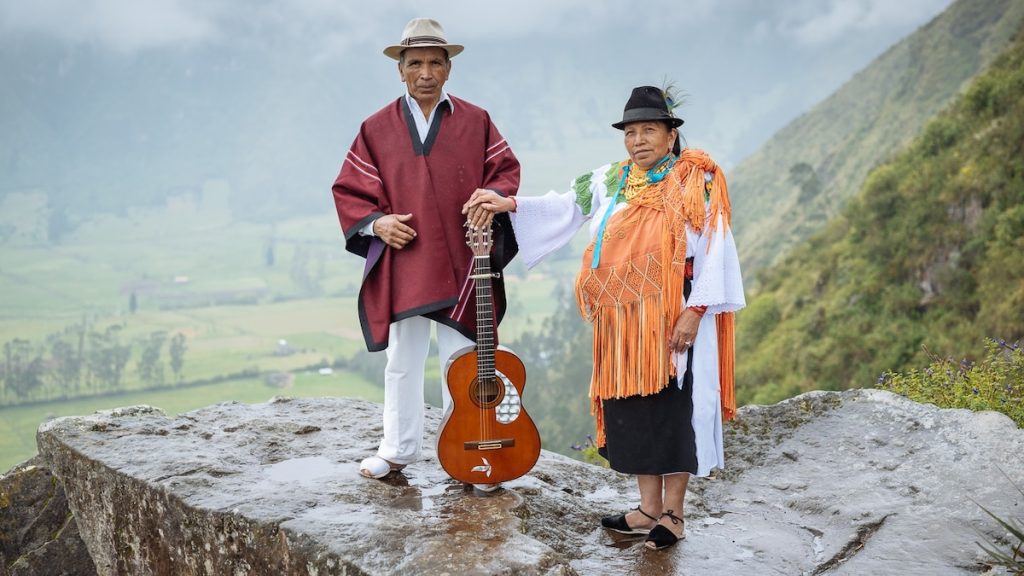“Madam ! Wait!”
I'm on the side of an Ecuadorian mountain and a woman in Andean dress has just speeded past on a motorbike, her peacock feather hat wrapped in a black bag to protect her from the rain.
The woman, named Mayra Perugachi, stops, turns and mocks our crew with our cameras and hopeful faces. She smiles willingly for her close-up, smoothing her embroidered brown skirt and adjusting her gold beaded necklace.
We follow her into the mountains, because we share the same destination: La Magdalena, a community within the parish (parish) of Angochagua, in the province of Imbabura. The communities of Angochagua offer visitors a glimpse into the lives of the indigenous Andean Kichwa people, including food, crafts, and rituals.
“We hike, we horseback ride, we milk cows, we paint wool,” says Tania Endara, leader of the community of La Magdalena, as she shows us into La Casa de los Girasoles: a family home and tourist center. “Each house tries to show its normal life.”

The women of the Angochagua community are world-renowned for their brightly colored weaving and embroidery. Photography by Ben Pipe
On a woven tablecloth are jugs of blackberry juice and baskets of Tiesto tortillasthe soft corn tortillas that have been a staple here for centuries. “Everything has been made by our own hands since pre-Inca times,” Tania says. “We are proud of our culture.”
Despite their pride, the Andean Kichwa are threatened by technology and globalization. “The older people speak Kichwa fluently,” Tania says. “But the younger ones speak a mixture of Kichwa and Spanish, and the younger ones speak Spanish fluently.” Tourism provides the Kichwa with an economic incentive to preserve their traditions and language.
After breakfast, we head deeper into the mountains to meet the community of Angochagua, which shares its name with the larger parish. We stop and walk a short distance to the top of a cloud-capped hill. Upon arrival, we are swept along by the galloping rhythms of a cumbia group: guitar, accordion and a metal guiro with rough ridges.
Community leader Milton Chuquin calls for silence as he begins a ritual to cleanse bad energy and remind those gathered what’s truly important—a spiritual reset, so to speak. Before him, Ecuador’s natural riches are scattered in a spiral: fruits, herbs, and rose petals, along with a clay pot filled with water and a harmonica. “The spiral represents our lives and our needs,” he says. “We need food, water, and air, yes, but we don’t just live to breathe. We live to create.”
He then picks up the harmonica and blows a solitary note. Even the birds seem to have fallen silent. “What is money, when you get to the end?” he cries. “What is money, if it was earned by exploiting the forests, by exploiting the Earth? Our responsibility is to serve the planet.”

Imelda Chuquin, member of the Rinconoda community, Angochagua parish, Imbabura province, Ecuador. Photography by Ben Pipe

Carlos Chuquin, member of the Rinconoda community, Parochia of Angochagua, Imbabura province in Ecuador. Photography by Ben Pipe
Once the ritual is over, the orchestra resumes and the villagers dance around the spiral. “We are really just passengers on this Earth,” Milton tells me. “We want people to learn our customs so they can take better care of our planet.”
We descend to the community of La Rinconada, known for its traditional ceramics. In the Allpa Manka workshop, visitors learn how clay vessels are made and can try to make them themselves.
Artisan David Guamán picks up a dull gray stone. “We extract clay from these mountains, just like we did centuries ago,” he explains. He crushes it with a wooden stick, then sifts the granules into a metal pan, ready to be mixed with water.
José Alvear, president of the Angochagua parish, joins me. “You don’t see much plastic here,” he says with a smile, as David lays out a leather skin on which he begins to knead the clay.

The Chilco community, parish of Angochagua in the province of Imbabura in Ecuador, gathers to play music. Photography by Ben Pipe
“Our goal is to preserve the heritage of our ancestors among young people,” José continues. “Tourism strengthens our economy and allows us to show our culture and roots to the world.”
Among the different communities of Angochagua, perhaps the most documented is that of Zuleta. Hacienda Zuleta The estate is still partly owned by the Plaza Lasso family, who have given Ecuador two presidents. The latter, Galo Plaza Lasso, instituted land reforms that returned large tracts of land to indigenous families. The indigenous Zuleteños are known for their embroidery: they sell their products locally and teach their skills to visitors to the hacienda (now a hotel).
At La Casa del Bordado, one of the many embroidery shops in the village of Zuleta, I meet Tania Bozmediano and Maria Chachalo, who are sewing peacefully amidst a multitude of flowery handkerchiefs.
“Everything we do is in tune with the natural environment we have, the flowers and the mountains,” Tania tells me. “Every garment we create is unique; you won’t find it anywhere else.”
“About 45, 46 years: that’s the time during which this work has allowed me to support myself, my family, my children and their education,” adds Maria. “Not on a large scale, no. But at least on a level where we realize that we don’t lack much.”
Daily international flights connect Ecuador's capital, Quito, from Madrid, Amsterdam and US cities. Please follow FCDO guidelines when travelling to the country. For more information, visit equateur.travel/en
To subscribe to National Geographic Traveler (UK) magazine click here. (Available in certain countries only).


